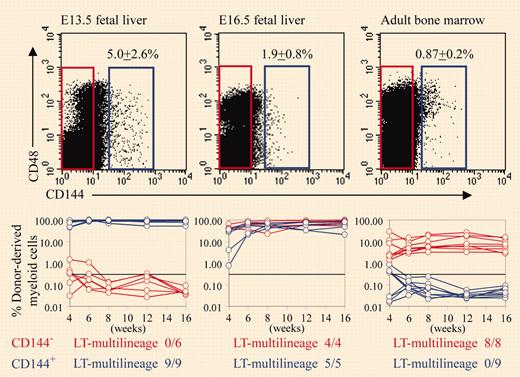Comment on Kim et al, page 903
VE-cadherin, an adhesion molecule thought to be exclusively expressed on endothelial cells, has now been identified on fetal hematopoietic stem cells.
Accumulating evidence supports the existence of a common hematopoietic/endothelial stem cell during early embryonic development,1 and recent studies suggest that cells with hemangioblast activity persist into adult life in both mice2,3 and humans.4 Gene targeting of embryonic stem cells reveals that a number of regulatory molecules including Runx-1, SCL, and fetal liver kinase-1 (FLK-1) are important for the specification of both blood and blood vessels in the early embryo. Many of the genes originally thought to be exclusively expressed in vascular endothelium have turned up in hematopoietic stem/progenitor cells (HSCs), while transcription factors and membrane receptors first associated with HSCs have been identified in the endothelial cell compartment. Consequently, these overlapping patterns of gene expression have led to an ever-diminishing list of endothelial-specific genes.FIG1
E13.5 fetal liver HSCs express the endothelial marker CD144 (VE-cadherin), but CD144 expression by HSCs declines over time and is no longer detected on adult bone marrow HSCs. See the complete figure in the article beginning on page 903.
E13.5 fetal liver HSCs express the endothelial marker CD144 (VE-cadherin), but CD144 expression by HSCs declines over time and is no longer detected on adult bone marrow HSCs. See the complete figure in the article beginning on page 903.
Vascular endothelial (VE)–cadherin (CD144) is an adhesion molecule that mediates cell-cell contact between endothelial cells.5 Reporter gene analysis shows that VE-cadherin is expressed in virtually all vascular structures including the blood islands of the yolk sac, the developing aorta, and capillaries of the brain. In the adult, continued expression in the endothelium is found throughout the vascular system. Targeted disruption of VE-cadherin impairs the remodeling, maturation, and survival of endothelial cells, ultimately leading to embryonic lethality. Constitutive expression in vascular tissue coupled with important functional activity has led to the widely accepted concept that VE-cadherin is endothelial cell specific. Careful investigation of the fetal HSC compartment once again challenges the notion of endothelial-specific genes.
In this issue of Blood, Kim and colleagues, using a combination of microarray analysis and quantitative polymerase chain reaction (qPCR), report that the levels of VE-cadherin expression are 13- to 50-fold greater in fetal liver HSCs compared with adult bone marrow (BM) HSCs. By sorting embryonic day (E) 13.5 fetal liver based on CD144 expression, they convincingly demonstrate that essentially all of the transplantable HSC activity segregates to the CD144+ cell fraction. However, on E16.5, both the CD144+ and CD144– fractions contain functional HSCs as determined using both primary and secondary transplantation assays. By contrast, all HSC activity in adult BM was found in the CD144– cell population. In addition to identifying a novel marker for enriching E13.5 FL HSCs, this study provides additional evidence of the phenotypic overlap between early HSCs and vascular endothelium, further underscoring the close relationship between hematopoiesis and blood vessels.6 The results of this study also illustrate the importance of using a panel of markers in order to reliably distinguish fetal HSCs and endothelial cells. ▪


This feature is available to Subscribers Only
Sign In or Create an Account Close Modal